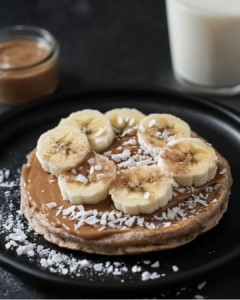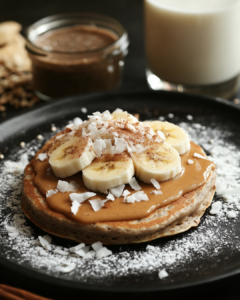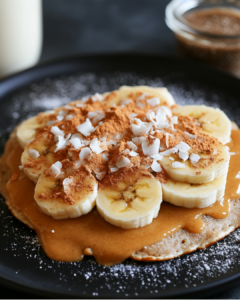Free Gluten pancakes have become a breakfast sensation, allowing people with gluten intolerance, celiac disease, or those choosing lifestyle to enjoy one of the classic morning delights.
Traditionally, pancakes are made with wheat flour, but the rise in awareness about gluten sensitivity has led to innovative alternatives that deliver both taste and texture without gluten. This easy gluten-free pancakes recipe uses a blend of gluten-free flours to create fluffy, golden pancakes loved by everyone at the table.
Whether you’re new to gluten-free baking or a seasoned pro, mastering gluten-free pancakes opens a world of versatile and satisfying breakfast options. The key to perfect gluten-free pancakes lies in selecting the right flour blend and balancing moisture with structure.
While gluten provides elasticity in traditional recipes, this gluten-free version uses binding agents and high-quality flours for excellent results.
For more on the science behind gluten-free flours, check out the comprehensive guide at Celiac Disease Foundation (https://celiac.org/live-gluten-free/glutenfreediet/food-options/). With the right ingredients and techniques, you’ll find that gluten-free pancakes can be every bit as fluffy and flavorful as their classic counterparts.
Enjoy experimenting with different toppings and additions to tailor your gluten-free pancakes to your taste.
Ingredients for Gluten-Free Pancakes
-
- 1 cup gluten-free all-purpose flour blend (with xanthan gum)
- 2 tablespoons sugar or coconut sugar
- 2 teaspoons baking powder (gluten-free)
- 1/2 teaspoon baking soda
-
- 1/4 teaspoon fine sea salt
- 1 cup milk or dairy-free alternative (almond, oat, or soy milk)
- 2 large eggs
- 2 tablespoons melted unsalted butter or coconut oil, plus more for the pan
- 1 teaspoon pure vanilla extract
- Optional: 1/2 cup fresh blueberries or chocolate chips
Instructions for Making Pancakes
-
- In a large mixing bowl, whisk together the gluten-free flour blend, sugar, baking powder, baking soda, and salt until evenly distributed.
- In a separate bowl, whisk the milk, eggs, melted butter, and vanilla extract until fully combined.
- Pour the wet ingredients into the dry ingredients. Use a spatula to gently mix just until no dry streaks remain. Do not overmix; a few lumps are fine.
- If desired, fold in blueberries or chocolate chips for extra flavor.
-
- Let the batter rest for 5-10 minutes to allow it to thicken. This step helps the pancakes become fluffy.
- Preheat a nonstick or cast iron skillet over medium heat. Brush lightly with butter or oil.
- Pour 1/4 cup of batter onto the skillet for each pancake. Use the back of a spoon to gently spread into circles, if needed.
- Cook until bubbles form on the surface and the edges look set, about 2-3 minutes. Flip and cook for another 1-2 minutes until golden and cooked through.

- Transfer cooked pancakes to a plate and cover loosely with foil to keep warm while cooking the rest.
- Serve warm with your favorite toppings such as maple syrup, berries, or nut butter.
Nutritional Information
The absence of gluten does not reduce the caloric value, but opting for whole grain or nut-based flours can enhance the fiber and micronutrient content. Choosing a dairy-free milk and using coconut oil makes this recipe suitable for those with dairy allergies or those following a plant-based diet.
For detailed nutritional profiles of various gluten-free flours, you can visit Healthline’s guide to gluten-free flours (https://www.healthline.com/nutrition/gluten-free-flour). Adding fruits like blueberries increases antioxidant content, while serving with nuts or seeds boosts healthy fat and protein.
Remember, toppings will affect the overall nutrition, so consider fresh fruit or a modest drizzle of maple syrup for a balanced meal. Gluten-free pancakes are lighter on the digestive system for those with celiac disease or gluten sensitivity, making them a smart choice for many dietary needs.
Wine/Beverage Pairings With Gluten-Free Pancakes
Gluten-free pancakes pair delightfully with a range of beverages. For a comforting morning meal, serve them alongside a rich, freshly brewed coffee or a creamy latte—both highlight the subtle sweetness of the pancakes.
Herbal teas such as chamomile, rooibos, or chai bring warmth and aromatic notes that complement fruity or nutty pancake toppings. If you prefer a cold drink, a glass of freshly squeezed orange juice or a green smoothie with spinach, banana, and almond milk are refreshing, nutrient-rich options.
For a sophisticated brunch, a sparkling mimosa or a glass of Prosecco adds a festive touch and balances the richness of the gluten-free pancakes. Dairy-free hot chocolates or matcha lattes also pair well, especially for those following a plant-based diet.
Cooking Tips and Variations
<p>For the fluffiest gluten-free pancakes, ensure your gluten-free flour blend contains xanthan gum or guar gum, as these are crucial for binding and structure—without them, pancakes can turn out crumbly. If your blend lacks these, add 1/2 teaspoon per cup of flour.
Letting the batter rest for 5-10 minutes before cooking allows the starches to hydrate, yielding lighter and more cohesive pancakes. For those who prefer dairy-free or vegan pancakes, substitute eggs with flax eggs (1 tablespoon flaxseed meal + 2.5 tablespoons water per egg) and choose plant-based milk.
If you like a nutty flavor, almond flour can be swapped in for part of the flour blend, but remember it will make the pancakes more tender and slightly denser. Try adding a dash of cinnamon, nutmeg, or lemon zest to the batter for extra flavor.
Experiment with mix-ins like diced apples, raspberries, or even shredded coconut. Freezing leftovers is easy—layer cooled pancakes between parchment paper and freeze in an airtight container. Reheat in a toaster or skillet for a quick breakfast.
For more tips on gluten-free baking techniques, visit King Arthur Baking’s gluten-free resource page (https://www.kingarthurbaking.com/learn/guides/gluten-free).
Serving Gluten-Free Pancakes
Serving gluten-free pancakes is all about creativity and personalization. For a classic touch, top your stack with a generous drizzle of pure maple syrup and a pat of butter (or vegan alternative). Fresh berries like blueberries, raspberries, or sliced strawberries add vibrant color, natural sweetness, and a boost of antioxidants.
For added indulgence, sprinkle the pancakes with dark chocolate chips or a dusting of powdered sugar. If you’re looking for extra protein, serve with a dollop of Greek yogurt or coconut yogurt and a sprinkle of chia seeds or crushed nuts.
To turn breakfast into a brunch, arrange the pancakes on a large platter, garnish with mint leaves, and offer sides of nut butters, fruit compotes, and whipped cream. For a savory twist, serve gluten-free pancakes with smoked salmon, avocado slices, and a squeeze of lemon.</p>
If preparing for a crowd, keep pancakes warm in a low oven (200°F/95°C) while cooking the entire batch. Presenting gluten-free pancakes beautifully ensures everyone, whether gluten-free or not, feels invited and satisfied.

Pancakes Health Benefits Gluten-free pancakes offer significant health benefits for individuals with celiac disease, non-celiac gluten sensitivity, or wheat allergies. By eliminating gluten, these pancakes help prevent intestinal inflammation, discomfort, and long-term complications associated with gluten ingestion in sensitive individuals.
Gluten-free pancake recipes often use alternative flours such as almond, oat, or brown rice, which can be higher in fiber, healthy fats, and essential vitamins compared to refined wheat flour. Incorporating whole food ingredients like eggs, plant-based milks, and fruits further boosts the nutritional value, providing sustained energy and satiety.
Additionally, gluten-free pancakes can be easily adapted to exclude other common allergens, such as dairy, eggs, or nuts, making them inclusive for a wide variety of dietary needs.

Gluten-free doesn’t automatically mean healthier for everyone. However, for those who need it, gluten-free pancakes offer a wholesome and tasty option. They support digestive health and promote overall well-being.
Yes, eggs can be replaced with flax eggs. Mix 1 tablespoon of ground flaxseed with 2.5 tablespoons of water per egg. You can also use a commercial egg replacer. This makes your pancakes both vegan and allergen-friendly. This creates a vegan and allergen-friendly gluten-free pancake.
<h3>Why are my gluten-free pancakes coming out gummy or dense?
Gummy or dense pancakes usually result from overmixing the batter or using too much liquid. Ensure your flour blend contains xanthan or guar gum for better texture, and let the batter rest before cooking.
Can I freeze gluten-free pancakes?
Absolutely! Let pancakes cool completely, then stack between parchment paper and store in an airtight container in the freezer for up to 2 months. Reheat in a toaster or skillet.
<h3>What is the best gluten-free flour for pancakes?
A high-quality gluten-free all-purpose blend with xanthan gum works best. You can also try blends with rice, potato, and tapioca flours, or experiment with almond or oat flour for different flavors and textures.</p>
pancakes are delicious and nutritious for everyone, making them an excellent option regardless of dietary needs.
Gluten pancakes offer the perfect blend of comfort, nutrition, and inclusivity for any breakfast table. With the right ingredients and a few simple techniques, you can achieve pancakes that are just as fluffy and flavorful as traditional ones—without any gluten. Whether you’re cooking for someone with dietary restrictions or simply exploring new breakfast recipes, gluten-free pancakes are a reliable and delicious choice. Enjoy them with your favorite toppings, experiment with different flours, and savor a breakfast that everyone can enjoy. Try this gluten-free pancake recipe today and redefine your morning routine.

